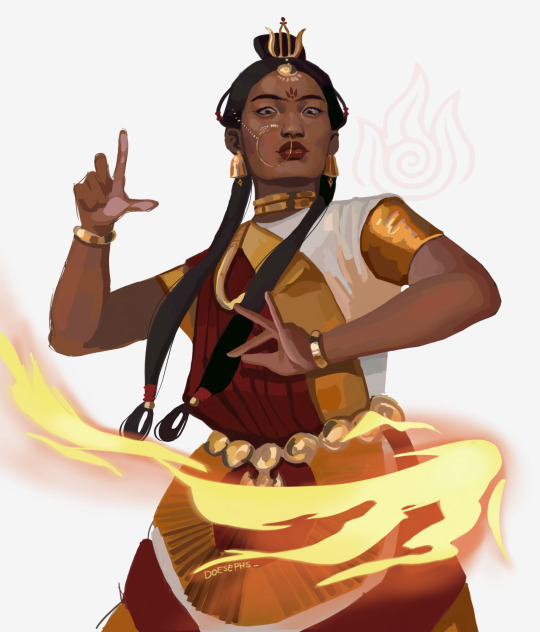#indian paintings
Text
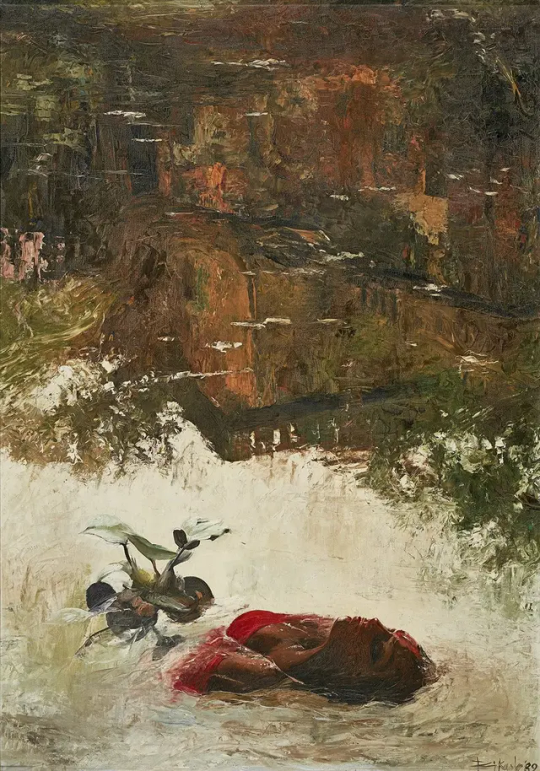
Bisarjan (immersion) ,1989
Bikash Bhattacharjee
Bisarjan (immersion) is a hindu ritual where the idols of the Gods are plunged in water bodies after festivals dedicated to worship them is over.
Among the bengali hindus the greatest religious festival is the Durga puja where goddess durga (an abatar of cosmic power or shakti ) is worshipped for 5days at the beginning of the autumn . On dashami the rituals of the 5days long worship ends with the idols being submerged in a river or nearby water body . Giving a endearing twist to the eternal story of Gods rescuing mankind from the arch evil , the bengali Hindus also views Goddess Durga as their own daughter who comes to spend five days in her maternal house and leaves for the Himalayas (her husband's home) on the day of Dashami. In bengali psyche and imagination the cosmic omnipotent Goddess is therefore often inseparable from the mortal daughters of the land suffering the usual plights of a daughter , mother and wife . This is one of the finest example of seeing the divine in mundane and vice versa .
Bikash Bhattacharjee's celebrates this spirit with a series of uncanny , surreal paintings collectively called 'Durga' where Durga is everywhere , in every woman , from holy pedestal to unholy brothels . In this painting we see the half submerged body (or corpse) of a woman whose divinity is apparent only through her third eye smeared in vermilion .
#morbid musings#colours of blues#Bikash Bhattacharjee#indian art#indian paintings#indian paintbrush#bengali artist#durgapuja
2 notes
·
View notes
Text
Unity in diversity makes Indian culture unique

View On WordPress
#Art#Art History#art of india#book#Buddha#Buddhism#Decorative Art#ebook#Gupta Period#Hindu#Hinduism#history#India#Indian#indian art#Indian paintings#Islamic Period#Jetavanaramaya#kindle book#Maharani Chimnabai#Mauryan Period#medieval#Medieval Art#painting#Parkstone#Parkstone International#postaday#postaweek#Raja Ravi Varma#religious
1 note
·
View note
Text

Indian tribal paintings are an integral part of the tribal tradition. It is an art form where life and ingenuity are fused and it can never be separated. It reflects the culture of the people in the most authentic way.
Click below for more
https://www.indianetzone.com/51/indian_tribal_paintings.htm
0 notes
Text

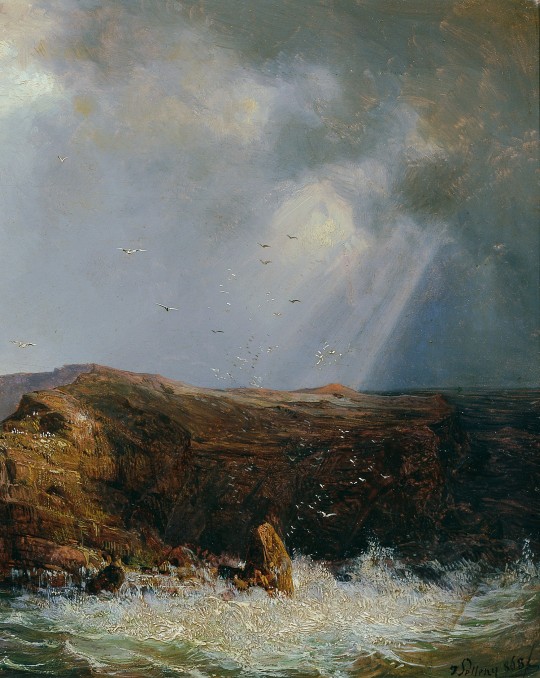
Joseph Selleny (Austrian, 1824–1875), "The Island of St. Paul in the Indian Ocean", 1868
#Joseph Selleny#art#austrian art#painting#landscape#landscape painting#seascape#seascape painting#marine art#maritime art#oil on panel#oil painting#island#ocean#indian ocean#19th century art#19th century#1860s#paintings#sea#aesthetic#art history
3K notes
·
View notes
Text
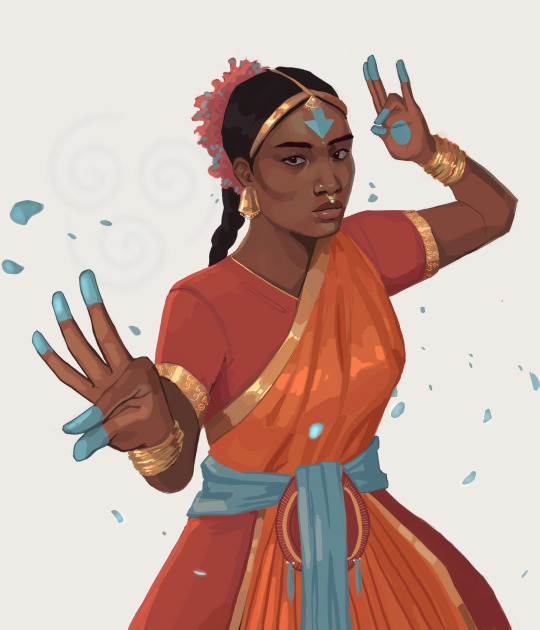
bharatnatyam air bender
#atla#avatar the last airbender#atla fanart#bharatnatyam#indian#air bender#digital art#digital painting
15K notes
·
View notes
Text
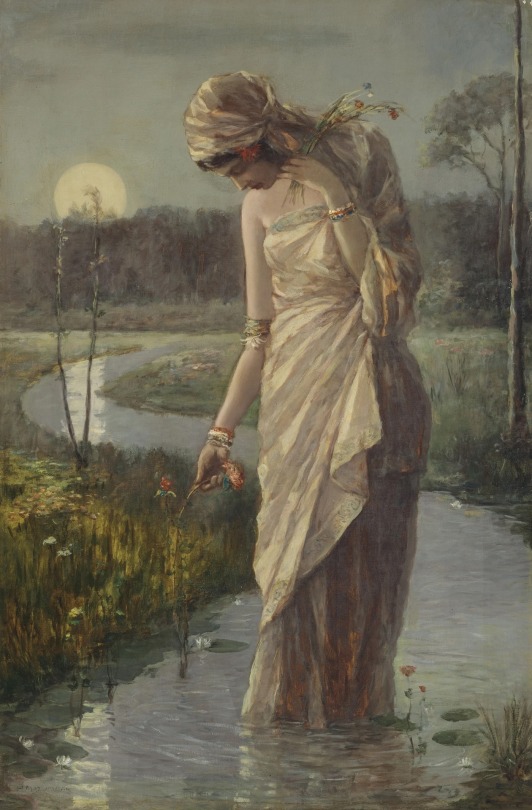
Untitled (Woman in Moonlight) by Hemendranath Mazumdar (Indian, 1894–1948)
4K notes
·
View notes
Photo

Lily Moth - Roos Holleman
Dutch , b. 1989 -
Piëzografie on 310 grs Hahnemühle German etching paper , 48 x 33 cm. Ed.33
#Roos Holleman#dutch artist#insect painting#lily moth#noctuidae family#lily caterpillar#Indian lily moth
13K notes
·
View notes
Text

first light by soumya netrabile, 2023, oil on canvas, 86 × 72 inches
3K notes
·
View notes
Text
Shop for beautiful religious paintings from Artoreal and bring a touch of spirituality to your home. Choose from a wide selection of stunning artwork depicting various religious themes and icons. Browse our collection and buy the perfect painting for your sacred space today!
#Religious Paintings#radha krishna painting#ganesha paintings#indian paintings#Indian Art Paintings#indian god painting#indian goddess painting#indian heritage and culture painting
1 note
·
View note
Text
#WatercolorWednesday:

Portrait of a Ladakhi Mountain Goat [Changthangi*]
India, Mughal dynasty, c.1601-25
Opaque watercolor, ink, gold on paper
37.9 × 25.6 cm (14 7/8 × 10 1/8 in.)
The Art Institute of Chicago 1919.944: https://www.artic.edu/artworks/76868/portrait-of-a-ladakhi-mountain-goat
🆔 “The Changthangi [aka Changpa, Ladakh Pashmina, Kashmiri] is a breed of cashmere goat native to the high plateaus of Ladakh in northern India. It is closely associated with the nomadic Changpa people of the Changthang plateau….The intense cold of the region causes the goats to grow a thick undercoat, which is harvested to produce the fine pashmina grade of cashmere.”
https://en.wikipedia.org/wiki/Changtha
#IndianArt #SouthAsianArt
#animals in art#painting#Indian art#South Asian art#Asian art#Mughal art#miniature#natural history art#goat#Changthangi#livestock#domesticated animals#watercolor#Watercolor Wednesday#Art Institute of Chicago
636 notes
·
View notes
Text
Pichwai Paintings | Shreenath Ji, Krishna Pichwai Paintings Online
Pichwai paintings are a traditional form of Indian painting that dates back to the 18th century. The word "Pichwai" comes from the Hindi word meaning "cloth painting." Pichwai paintings are typically done on cloth, though they can also be done on paper or canvas.
Pichwai paintings typically depict Hindu deities, such as Krishna, Radha, and Shiva. They are often brightly colored and highly decorative. Pichwai paintings are usually made in a series, with each painting telling a story from Hindu mythology.
Pichwai paintings are not only beautiful works of art, but they also offer a glimpse into Hindu culture and religion. If you're interested in learning more about Hinduism, Pichwai paintings are a great place to start. Pichwai paintings often depict scenes from the popular Hindu epic, the Mahabharata. The Mahabharata is a long and complex story that tells the tales of two warring branches of a royal family. The story is full of gods and goddesses, heroes and villains, and can be difficult to follow. However, the Pichwai paintings of the Mahabharata provide a helpful visual guide to the story.
Here are some of the best Pichwai paintings -
The Pichwai painting that depicts the birth of Krishna is said to be one of the most beautiful and popular Pichwai paintings.
Another popular Pichwai painting is one that shows Krishna and Radha enjoying a dance together.
The Pichwai painting that depicts the death of Shiva is also a popular choice.
There are also many Pichwai paintings that depict scenes from the Mahabharata, such as the battle between the Pandavas and the Kauravas.
Finally, there are also many Pichwai paintings that depict Hindu deities in their natural environment, such as Krishna playing his flute in a forest.
Let’s see how Pichwai painting is made -
The first step in making a Pichwai painting is to choose the right cloth. The cloth must be of a high quality and should be a dark color. Once the cloth is chosen, it is then primed with a mixture of powdered resin and chalk.
After the cloth is primed, the outlines of the painting are drawn on it. Once the outlines are complete, the painting is filled in with colors. Finally, the painting is varnished to protect it.
The preparation of a Pichwai painting for the temple backdrop can take a few weeks to several months. Wealthy families commission artwork for the temple, but there are also smaller replicas available for the average person to keep at home in their own shrines. Since it is forbidden to take photos inside the temple, Pichwai painters also create paintings of Shrinathji's idol in the same manner. This helps them with business and satisfies devotees who want to take an image of their lord with them.
The paintings come in a variety of sizes, with the cloth panels being larger and the paintings on paper having more features in them. Banana trees stand out in a sea of other trees, peacocks frolic while grey, blue, and white monsoon clouds curl across the indigo sky, cows graze on the countryside and along the well defined borders, and women dance with a dreamlike intensity.
The hanging exhibit enables the visitor to interact with the artwork and take in every nuance of the skilled touch of the creator. They are filled with ripe, rounded colours that are only constrained by precise geometry. In keeping with the motif, fillers like chattri, boats, lotuses, and orchards are strewn about in unexpected places.
The practise of using mineral compounds and vegetable dyes to paint on cloth is distinctive in many ways. Fashion designers and companies that sell home furnishings have grown to love this style of art. It has spread beyond the walls of temples and homes to include our attire. This is a step toward fostering creative awareness among the populace as well as a means of comprehending India's numerous folk and tribal styles.
0 notes
Text

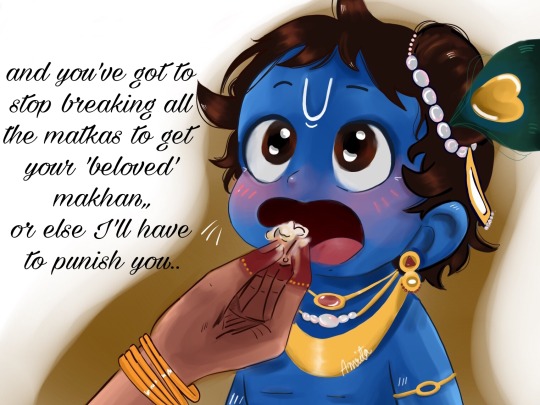

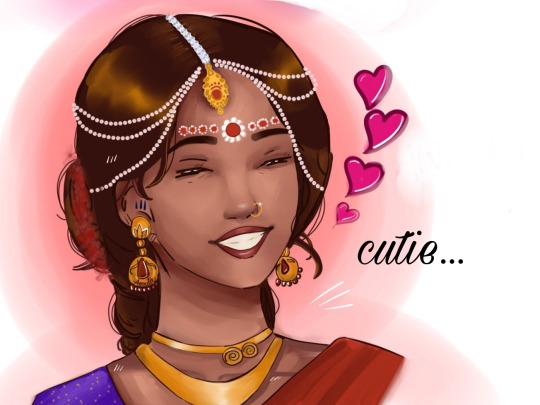
Yashoda maiyaa can never be mad at her kanhu for more than a minute 🥹
Happy Birthday to our sweet, precious 'Momma's Boi'.
HAPPY JANMASHTAMI!!!
#heheh#Janmashtami#y'all should know i dont really know how to....digital art? what#krishnablr#kanhaiya#krishna ji#gopiblr#kanha#desiblr ki gopiyan#krishna#kanhaji#desi tumblr#desiblr#being desi#desi tag#desi humor#hindublr#art#hinduism#hindu god#hindu gods#hindu deities#hindu#digital painting#comic#desi indian#desi girl#desi life#desi aesthetic#desi
503 notes
·
View notes
Text
THREE NEW SHARK SPECIES THIS WEEK!
The second week of July 2023 something extraordinarily beautiful happened, the findings of 3 new species of sharks for were announced
A new angel sharks species was identified, from the western Indian Ocean on the Mascarene Plateau and off southwestern India in 100–500 m depths, the Lea’s angel shark Squatina leae, was recognized to be different genetically and morphologically distinct from its congeneric species Squatina africanae, following unique morphological features. This species was first detected in 1988 after finding three unusual, small sharks, but till today was completely understood. The angel shark is named after one of the author’s fiancee’s late sister, Lea-Marie Cordt.

- Squatina leae, adult male, in dorsolateral.
Angel sharks are “flatter sharks”, possesing distinctly broad, dorsoventrally flattened bodies, a short snout with large mouth and nostrils, eyes on top of the head close to the large spiracles, very large pectoral fins, and a lateral caudal keel. They've evolved to be ambush predators, they lie in wait for prey to pass closely overhead before attacking.
Reference (Open Access): Weigmann et al., 2023. Revision of the Western Indian Ocean Angel Sharks, Genus Squatina (Squatiniformes, Squatinidae), with Description of a New Species and Redescription of the African Angel Shark Squatina africana Regan, 1908. Biology
From North Australia, another species of hornshark is described based on six whole specimens and a single egg case. The painted hornshark Heterodontus marshallae was previously considered to be the same with the zebra bullhead shark another well know bullhead shark from the central Indo-Pacific from Japan to Australia, but genetic and morphological analyses indicated the sharks were different, but looking alike. The painted hornshark is endemic to northwestern Australia and occurs in deeper waters, at 125–229 m below surface.

- Lateral view of two mature female painted hornshark Heterodontus marshallae showing small differences between individuals
The painted hornsharks is named in honour of Dr. Lindsay Marshall www.stickfigurefish.com.au a scientific illustrator and elasmobranch scientist who expertly painted all the sharks and rays of the world for the Chondrichthyan Tree of Life Project.
Reference (Open Access): White et al., 2023 Species in Disguise: A New Species of Hornshark from Northern Australia (Heterodontiformes: Heterodontidae). Diversity.
And from an unidentified shark egg collected from the deep waters of northwestern Australia, in 2011 recently helped researchers identify a new species of deep water cat shark. Called ridged-egg catshark Apristurus ovicorrugatus after its eggs, it was collected in the earlys 90 but remained unknown to date. This sharks presents white eyes, and is small in size, reaching less than a half meter in length. .
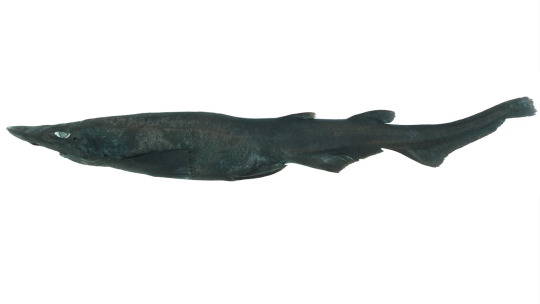
- Lateral view of female Apristurus ovicorrugatus before preserved. Photo by CSIRO.
Egg cases belonging to this species had been documented as early as the 1980s, but could not be matched to any species of Australian shark until recently scientists examined a shark specimen of previously uncertain identity in the CSIRO collection.

-egg cases of Apristurus ovicorrugatus. Scale bar is 10 mm
Reference (Open Access) White,et al., 2023 What came first, the shark or the egg? Discovery of a new species of deepwater shark by investigation of egg case morphology. Journal of Fish Biology.
#Squatina leae#Squatina#new species#elasmobranch#shark#biology#marine biology#science#marine science#indian ocean#bioblr#sciblr#sci#painted hornshark#Heterodontus marshallae#Heterodontus#Apristurus ovicorrugatus#Apristurus#long post#Ridged-egg catshark#Lea’s angel shark
3K notes
·
View notes
Text
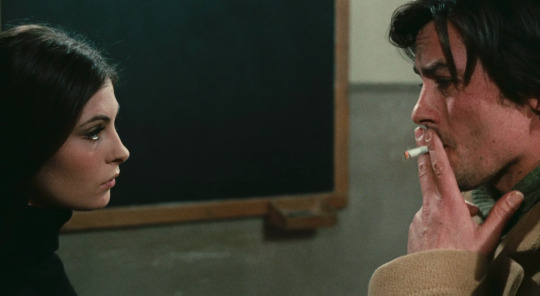
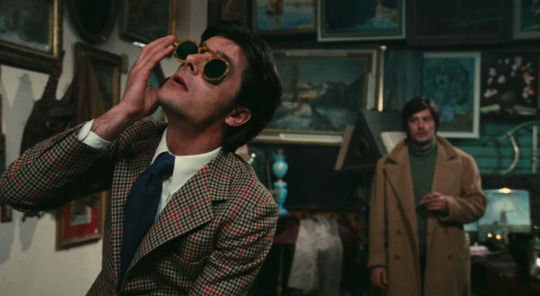
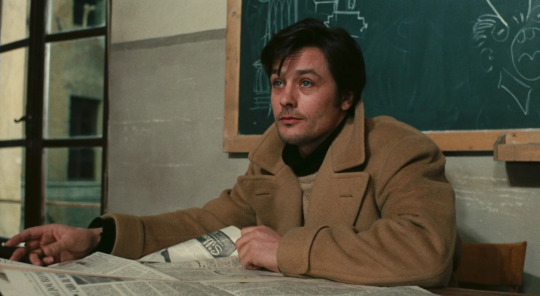
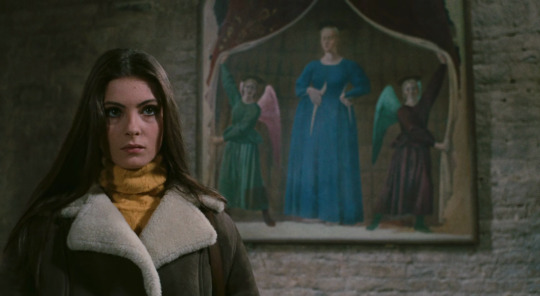


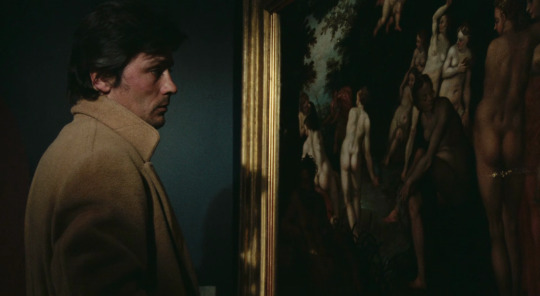
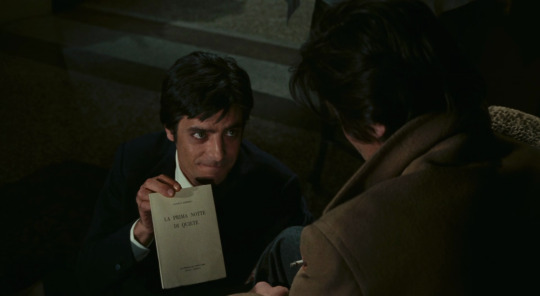


La prima notte di quiete (Valerio Zurlini, 1972)
#Films watched in 2024#La prima notte di quiete#Indian Summer#Zurlini#Valerio Zurlini#1972#Alain Delon#Sonia Petrovna#drama#Giancarlo Giannini#Lea Massari#love#school#jealousy#drink#smoke#sunglasses#car#cars#alcohol#art#painting#paintings#ocho
348 notes
·
View notes
Text

Unknown, Mughal
A Tall Flower with Pink Blossoms
c. 1770
opaque watercolor on paper
sheet: 7 1/8 x 3 3/4 in. (18.1 x 9.5 cm)
Williams College Museum of Art
287 notes
·
View notes
